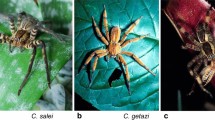Abstract
Drones (Apis mellifera ♂) were attracted to a lure scented with queen pheromone suspended at a height of 11–18m. An unscented test object, usually a black sphere, was lowered on a vertical string at a horizontal distance of 50 cm or 103 cm from the scented lure. Drones often made a rapid, direct, displacement from the scented lure to the test object. Drones responded to objects that subtended an angle as small as 0.41° which is less than the acceptance angle of a single ommatidium. We calculate that a drone can respond to a stimulus corresponding to a reduction in the light incident on one ommatidium at a time of 8%; the brevity of the stimulus on each ommatidium would seem to be a factor in the design of the eye.
Similar content being viewed by others
References
Coles JA, Schneider-Picard G (1989) Amplification of small signals by voltage-gated sodium channels in drone photoreceptors. J Comp Physiol A 165:109–118
Collett TS, Land MF (1975) Visual control of flight behaviour in the hoverfly Syritta pipiens L. J Comp Physiol 99:1–66
Edrich W (1991) Ein erstaunliches Reaktionsvermögen von Drohnen auf visuelle Bewegungsreize. Verh Dtsch Zool Ges 84:341
Gary NE (1962) Chemical mating attractants in the queen honey bee. Science 136:773–774
Hecht S, Wolf E (1929) The visual acuity of the honey bee. J Gen Physiol 12:727–760
Jean-Prost P (1958) Résumé des observations sur le vol nuptial des reines d'abeilles. Proc Int Beekeep Congr Rome 17:404–408
Kirschfeld K, Wenk P (1976) The dorsal compound eye of simuliid flies. Z Naturforsch 3lc: 764–765
Land MF (1989) Variations in the structure and design of compound eyes. In: Stavenga DG, Hardie RC (eds) Facets of vision. Springer, Berlin Heidelberg New York, pp 90–111
Land MF, Collett TS (1974) Chasing behaviour of houseflies (Fanma canicularis). A description and analysis. J Comp Physiol 89:331–357
Mazokhin-Porshnyakov GA (1969) Insect vision. Plenum, New York
Oertel E (1956) Observations on the flight of drone honey bees. Ann Entomol Soc Am 49:497–500
Praagh JP van, Ribi W, Wehrhahn C, Wittmann D (1980) Drones fixate the queen with the dorsal frontal part of their compound eyes. J Comp Physiol 136:263–266
Seidl R (1982) Die Sehfelder und Ommatidien-Divergenzwinkel von Arbeiterin, Königin und Drohne der Honigbiene (Apis mellifica). PhD Thesis, Techn Hochsch Darmstadt
Shaw SR (1969) Interreceptor coupling in ommatidia of drone honeybee and locust compound eyes. Vision Res 9:999–1029
Snyder AW (1977) Acuity of compound eyes: physical limitations and design. J Comp Physiol 116:161–182
Srinivasan MV, Lehrer M (1984) Temporal acuity of honeybee vision: behavioural studies using moving stimuli. J Comp Physiol A 155:297–312
Srinivasan MV, Lehrer M, Kirchner WH, Zhang SW (1991) Range perception through apparent image speed in freely flying honeybees. Visual Neurosci 6:519–535
Stavenga DG (1992) Eye regionalization and spectral tuning of retinal pigments in insects. Trends Neurosci 15:213–218
Toyoda J, Hashimoto H, Anno H, Tomita T (1970) The rod response in the frog as studied by intracellular recording. Vision Res 10:1093–1100
Vallet AM (1992) Comportement visuel du mâle d'abeille et électrophysiologie des cellules photoréceptrices. PhD Thesis, University of Bordeaux II
Vallet AM, Coles JA (1991) A method for estimating the minimum visual stimulus that evokes a behavioural response in the drone Apis mellifera. Vision Res 31:1453–1455
Vallet AM, Coles JA, Eilbeck JC, Scott AC (1992) Membrane conductances involved in amplification of small signals by sodium channels in photoreceptors of drone honey bee. J Physiol (Lond) 456:303–324
Wolf E (1933) The visual intensity discrimination of the honeybee. J Gen Physiol 16:407–422




